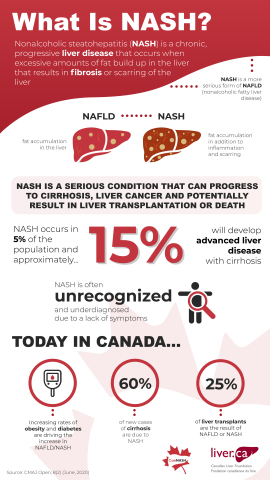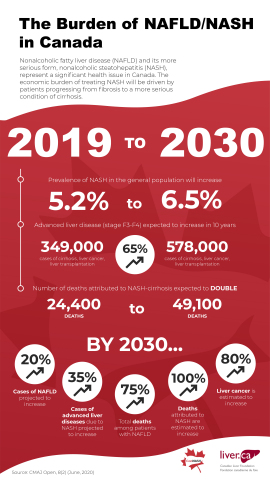TORONTO--(BUSINESS WIRE)--The first-ever Canadian study to forecast the growing burden of nonalcoholic fatty liver disease (NAFLD or “fatty liver disease”) and its more severe form, nonalcoholic steatohepatitis (NASH), affirms that the liver conditions are an escalating public health issue, with NASH cases increasing by 35 per cent and deaths expected to double to 49,100 (from 24,400 in 2019) in Canada over the next decade.
The study, conducted by The Canadian NASH Network (CanNASH), recommends immediate understanding, evaluation and intervention options to “avert the epidemic” of NAFLD-related liver disease in Canada. NAFLD is caused by the accumulation of fat in the liver of people who drink little or no alcohol.
According to “Burden of nonalcoholic fatty liver disease in Canada 2019-2030”, published in CMAJ Open, 8(2) (June, 2020), the incidence of serious liver-related consequences as a result of NASH are expected to increase substantially. Cases of end-stage liver disease (liver failure), liver cancer or liver transplantation, are expected to increase by 65 per cent by 2030 (to 578,000 cases from 349,000 cases in 2019). In the next decade, NASH-related liver deaths are expected to account for 11.3 per cent of total deaths in Canada (up from 10.9 per cent in 2019).
“In the next 10 years, we expect the economic burden to treat NASH will be driven by patients progressing from fibrosis to the more serious condition of cirrhosis,” says Dr. Mark Swain, Director of the University of Calgary’s Gastroenterology and Hepatology division, study author and member of the CanNASH Steering Committee. “We estimate the number of people with decompensated cirrhosis will double by 2030 and cases of liver cancer will increase by 80 per cent. As a result, NASH-cirrhosis is estimated to soon become the number one indication for liver transplantation.”
NASH is a chronic, progressive liver disease that occurs when excessive amounts of fat build up in the liver, resulting in fibrosis or scarring of the liver. It is a serious condition that can progress to cirrhosis and potentially result in the need for liver transplantation or death. Among the five per cent of Canadians with NASH, approximately 17 per cent are predicted to have advanced disease.
“There is a growing disease burden associated with fatty liver disease as rates of diabetes and obesity increase in Canada and globally,” says Dr. Alnoor Ramji, Clinical Associate Professor at the University of British Columbia (Vancouver), study author and member of the CanNASH Steering Committee. “Even if further increases in obesity and diabetes in Canada are halted, NAFLD-related illnesses and death are projected to increase for decades. This analysis gives us a detailed look at future disease incidences and can help to reinforce the need for health services, community services and public policies to positively influence health and lifestyle behaviours.”
While NAFLD is often unrecognized and underdiagnosed due to a lack of symptoms, people with risk factors like obesity and diabetes, will be more prone to developing NASH. Persons with obesity and diabetes should be evaluated for fatty liver disease.
“Unfortunately, the combination of obesity and diabetes within an aging population has created a ‘perfect storm’ for the progression of fatty liver disease,” observes Jennifer Nebesky, President and CEO of the Canadian Liver Foundation (CLF). “This is compounded by the fact that there is very little awareness about fatty liver among the general Canadian population. The CLF recently commissioned an Ipsos survey that shows that more than 70 per cent of respondents had either never heard of NAFLD or NASH or, at best, knew very little about them. Without this knowledge, individuals cannot work with their physicians to proactively detect and treat their illness, so the findings of this study—that the disease burden of NAFLD and NASH will increase—are likely more accurate than anyone would like to think.”
“The study modelling projections that point to significant increases in the incidences of NAFLD, the more serious NASH complications, liver transplantation and deaths, should be a wake-up call for patients, the medical community and provincial health ministries,” says Dr. Swain. “We need to respond with efforts to prevent the rising incidence of NAFLD as well as develop treatments to slow disease progression for those already impacted by advanced disease.”
CanNASH and the CLF represent the clinician/researcher and public/patient/caregiver communities in Canada and their shared mission is to improve liver health in Canada through research and education. NAFLD, including its more serious form NASH, is the leading form of liver disease in Canada, and CanNASH and the CLF are committed to working together to improve prevention, diagnosis, management and treatment of NAFLD and NASH.
About CanNASH
The Canadian NASH Network (CanNASH) is a collaborative organization of health care professionals from across Canada with a primary interest in enhancing understanding, care of, education and research in persons with NAFLD with a vision of best practices for this disease state. Its mandate is to: promote collaboration of clinicians and researchers in the study of NAFLD, and thereby increase research capacity and address clinically relevant research questions through shared data and resources; enhance the understanding of NAFLD by focusing on the themes of epidemiology, diagnostics, therapy and prevention; translate evidence into practice policy; and promote a national and global effort to recognize NAFLD as a major health issue. For more, visit www.Cannash.ca
About the Canadian Liver Foundation
Founded in 1969 by a group of doctors and business leaders concerned about the increasing incidence of liver disease, the Canadian Liver Foundation (CLF) was the first organization in the world devoted to providing support for research and education into the causes, diagnoses, prevention and treatment of all liver disease. It remains the only non-governmental organization in Canada focussed on liver health and the main source of non-profit charitable funding for all forms of liver research. Through its chapters across the country, the CLF strives to promote liver health, improve public awareness and understanding of liver disease, raise funds for research and provide support to individuals affected by liver disease. For more, visit www.liver.ca
Link to study: http://cmajopen.ca/content/8/2/E429.full



